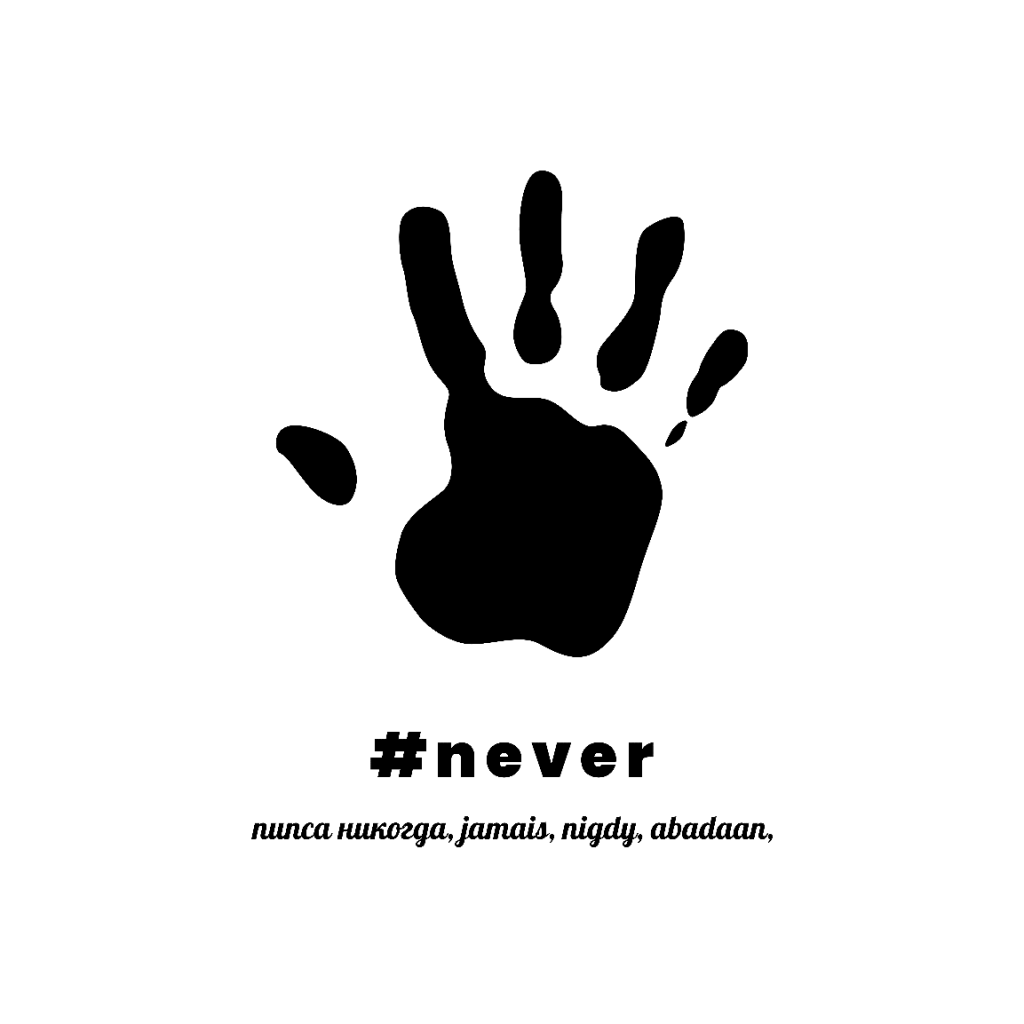# Never Campaign
#Nunca, # никогда, # Jamais, # Nigdy, # Abadaan
Sport and it’s stars tackle racism, homophobia, anti-Semitism and islamophobia through a new campaign.
Racist chants are not anything new on the football terraces of Central and Eastern Europe. The, frankly, sickening and defensive response of the Montenegro Team coach to accusations of racist chants, demonstrates that racism is virtually institutionalised in some of these countries.
What is happening on East European football terraces is also happening in many of their parliaments. The Croatian president thanks Argentina for taking in notorious pro-Nazi war criminals after World War II. In Bulgaria, a top politician calls the country’s Roma minority “ferocious humanoids.” And Hungary’s prime minister declares the “colour” of Europeans should not mix with that of Africans or Arabs.
In most of Europe, since WWII such views have been taboo – confined to the far-right fringes. Today they are openly expressed by mainstream political leaders in parts of Central and Eastern Europe, part of a populist surge in the face of globalization and mass migration. As Tom Junes, a historian with the Human and Social Studies Foundation in Sofia, Bulgaria, put it, “There is something broader going on in the region which has produced a patriotic, nativist, conservative discourse through which far-right ideas managed to become mainstream.”
In other parts of the world too, views long-thought outdated are being aired again, with World leaders like Hassanal Bolkiah and Kingdoms and Governments like Brunei threatening to issue death penalties for homosexual relationships.
We in Britain are, however, far from blameless. Racist, homophobic and anti-Semitic chants are still everyday features at sports grounds throughout the UK. Incidences of abuse are often being reported, but not enough is being done to tackle it. Members of the public still think they can make their views heard with immunity. As the former-England and Liverpool Footballer Stan Collymore said “People feel free to be openly racist”.
So how do we “bring the awareness and light to the situation”, as England and Manchester City Footballer Raheem Sterling so ably put it? It is time to step up and address this stain on the world of sport.
As transformative consultants, at DVC, we have worked with governments and corporates to tackle Islamophobia, terrorism and racism and we believe that education is key – the pollination of knowledge sharing through well-orchestrated thought leadership programmes. Thought leadership programmes which promote the stars of sport who represent different cultures and religions. Global sport enjoys a plethora of articulate and intelligent men and women who need to be given a co-ordinated and structured platform to get their message across.
We have therefore launched a new initiative #NEVER to campaign on these issues. We are building a campaign to put global sports stars at the forefront of educating and articulating that homophobia, anti-Semitism, racism and islamophobia is NEVER OK. The campaign slogan will be translated into multiple languages, and it will tackle the issues head on through a hard hitting series of ads which address each issue individually. The campaign will be both emotive and educational, but will not shy away from taking on the abuse head on. Criticism has been levelled at previous campaigns in the past, that they fail to expose the full extent of the problem.
We believe the campaign needs to be fully inclusive and embraced by the different sports governing bodies including FIFA, UEFA, FA, RFU, FIA, LTA, and ECCB. We are currently building consensus and support with these bodies, as well as Football and Rugby Premier League and Premiership Clubs It needs co-ordination and buy-in from government agencies so that the message can be disseminated both nationally and globally. It needs to utilise both traditional and social media. The campaign will also be cascaded through schools and universities. We have started to put together a pilot programme for this with two separate schools and a university.
Example of the types of messages the campaign will be built on are;
“ #NEVER scream or chant YID from the terraces. If you were to hold a minutes silence for each victim of the Holocaust you would be silent for 11 and a half years. NEVER Let this happen again. NUNCA, JAMAIS, NIGDY, НИКОГДА, ABADAAN”.
“#NEVER shriek monkey or animal noises at the sports stars performing. AFRICA is the cradle of humankind. Where do YOU think YOU came from? НИКОГДА, NIGDY, JAMAIS, NUNCA”.
We can learn from some of the actions taken by sporting clubs elsewhere in Europe. They put education at the heart of their policy and also believe in the importance of putting the full horrors of the consequence of peoples attitudes on show.
For example, Borussia Dortmund is leading football’s fight against the far- right, racism and anti-Semitism in Germany. The battle against has been a long and often challenging affair. During the 1980s and 1990s, the club attracted supporters from the far-right, including those from the infamous “Borussenfront” which became one of the country’s most feared hooligan gangs.
But a combination of the left-leaning Ultra movement and club projects, such as that undertaken at Dortmund, has helped to curb the far-right’s influence.
Long term fan Daniel Lörcher is very much at the heart of a new project that helps educate the club’s supporters on the horrors of the Holocaust. Running since 2011, the project takes supporters to concentration camps where a number of Jews from Dortmund were murdered. So far it has taken supporters to Auschwitz, Majdanek, Belzec and Treblinka, as well as Zamosc, a town in Nazi-occupied Poland where many Jewish families from Dortmund were transported to. “It is just a part of our program, but I would say the impact was very strong,” Lörcher told CNN in a recent interview.
“Right now we have an initiative against discrimination for supporters. We also educate also our employees who are very interested in this topic, and we have our stewards who are also taking part. “If there is an incident in the stadium, many people come up and say there is an incident and we would like to react. “We know that there can be an incident every time, but the reaction on the incident is very powerful.”
So, how does this work?
For this campaign to work across its multiple stakeholders it has to be collaborative. All stakeholders need to have input, but it needs co-ordination.
In commerce Thought Leadership has become the new battleground for B2B marketers fighting to differentiate their brand from the competition. By utilising new intellectual territory, a company can open up new commercial conversations. The same method can be used to tackle important issues like racism, homophobia and anti-semitism through creating a dialogue which educates, and helps to eradicate it.
Thought leadership has become the most powerful type of content marketing strategy for promoting all stages of a company’s brand growth. Why should it not be used to tackle the virulent growth of Islamophobia?
It is not only a great differentiator, allowing the promotion of insights and ideas, but creates real empathy with actual and prospective stakeholders. In the corporate world this has then ultimately driven commercial success. People like to learn from a company that is relevant, informed and not frightened to express an opinion. In the same way people respond to leaders on the important topics of today.
Thought Leadership and Social Media
As we previously stated, Thought Leadership is the new battleground for B2B marketers fighting to differentiate their brand from the competition. By utilising new intellectual territory, a company can open up new commercial conversations. But in our experience companies see social media and Thought Leadership as both friend and foe.
As companies invest more money and time in both Thought Leadership and social media, they risk missing a great deal of potential benefit they can achieve by bringing the two together in an integrated way.
All too often, at least in our experience in the tech sector, marketers investing in Thought Leadership view social media primarily as a channel for disseminating content. They understand that social media is important, and that relying on traditional media channels (including email and websites) to promote their ideas is no longer enough. As such, they’re putting Thought Leadership content into blog posts, tweets, videos, and the like — and use the plethora of platforms to promote that content as widely as possible in the social sphere.
This all good, but we think it’s far too limited a view. In fact, this is a more refined version of the same old one-way broadcast mentality. Wrap a cold towel around your head, confine yourself to a dark room and COGITATE! Do some research, produce a presentation or white paper, and then release it to the world and wait for the acclaim and customer/client inquiries to come rolling in. We did this very successfully at the end of the last century and early noughties.
“Going social” with content gives it a better chance of being seen, but a more collaborative approach to understanding stakeholder issues and creating new Points of View before even creating any content greatly raises the chances that stakeholders will actually be interested. This is vital in building the debate in the unacceptability of racism.
Socializing every aspect of the Thought Leadership process requires a more fundamental shift than just reformatting content and creating a longer checklist of places to publish. It means a fundamental sea change in attitudes. You have to abandon the thought that you own all the good thinking yourself, that you shouldn’t publish anything until it provides all the answers, and that Thought Leadership is about you talking and stakeholders listening. It is not, social media is all about listening, sharing and collaborating. How effective could it be to have those interested in the development of modern Islam in a collaborative approach with the likes of N’golo Kante and Mo Salah?
The reality is that a lot of great thinking and experience lies outside any one organisation. Stakeholders want to collaborate in developing new approaches and solutions, and the best way to demonstrate expertise is to ask the right questions and facilitate ongoing conversation. The virtuous circle of social media and Thought Leadership includes five main elements, demonstrated below:
- Stakeholder and market insight: Tapping social media and networks to dig deeper (and often faster) into the issues your stakeholders and prospects really care about. You can access the many channels now available but can also build your own stakeholder communities to ensure a steady flow of insight.
- Collaborative POV: Don’t rely on a single expert or an internal team. Work with all stakeholders to craft a more relevant and compelling POV to underpin Thought Leadership content. Sports personality interviews, fan roundtables, external working groups, academic and think tank partnerships can all be part of the thinking process, not simply vehicles to disseminate finished products. Social tools make these collaborations far easier and more affordable to manage.
- The best routes to market: This is the area marketers are already digging into, and with good reason. If you’re NOT taking advantage of social tools and networks to disseminate your Thought Leadership content, you’re missing an enormous opportunity to reach key stakeholders where they are increasingly spending their time searching for new ideas.
- Viral leverage: Your stakeholders and prospects trust independent experts far more than organisation spokespeople, and gaining their support is far more likely to trigger social media sharing than anything you do directly. Identifying and reaching out constructively to the new influencers in your markets (bloggers, analysts, community managers, etc.) is now essential to Thought Leadership success.
- Conversation and community: The old broadcast mode of Thought Leadership assumed a straight line from publication to customer inquiry to sales presentation. In a few cases of rare brilliance, this may even have occurred. In our vastly more networked world, stakeholders want to consider, analyse and debate your ideas at length — and often without you even being present. Inspiring, facilitating, and participating in the conversation is the right goal for Thought Leadership marketing, and using social platforms and communities is the best way to make this possible. It is also the best way to gain deep and ongoing stakeholder and market insight, which keeps the whole circle going.
Our Senior Management team has been at the forefront of developing global Thought Leadership plans for both governments and corporates for the last 25 years.
How do we achieve this?
- Analysing past stakeholders, socio- economic groups and trends
- Consulting relevant bodies and personnel
- Conducting face to face interviews at individual or focus group level to gain insight into ‘values, beliefs and prejudices
- Developing Frameworks to continually understand stakeholder needs
- Identifying key stakeholder groups and priorities in order to develop relevant stakeholder engagement and communication strategies and plans through Thought leadership
Why would you do this?
- Translate stakeholder needs into organisational goals and create the basis of effective strategy formation and strategy deployment
- Provide for an ongoing measurement programme that metrics and KPIs can be set against to monitor the success of the campaign
- Establish a framework for education and the eradication of Islamophobia, Racism and Anti-semitism
Thought Leadership- Cogitare
Cogitare-The Latin for “To Think, ” is the collective name for DVC Consultants thoughts, insights and perspectives on a broad and eclectic number of subjects. From Brexit to Global Poverty, Islamic Banking to Subsistence Agriculture, Disruptive Technologies to The World Bank. It reflects the wide range of sectors and issues we consult on. We hope you enjoy reading them.






0 Comments